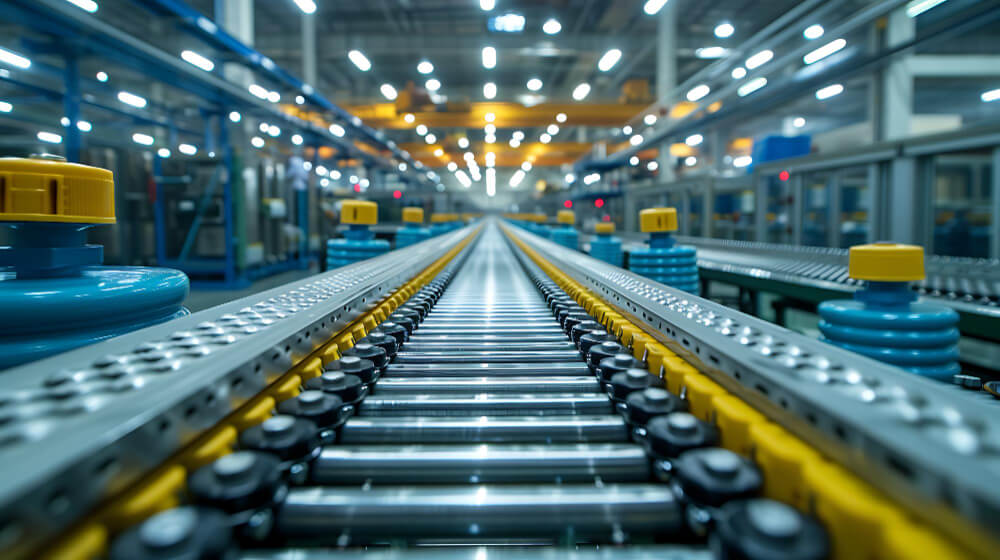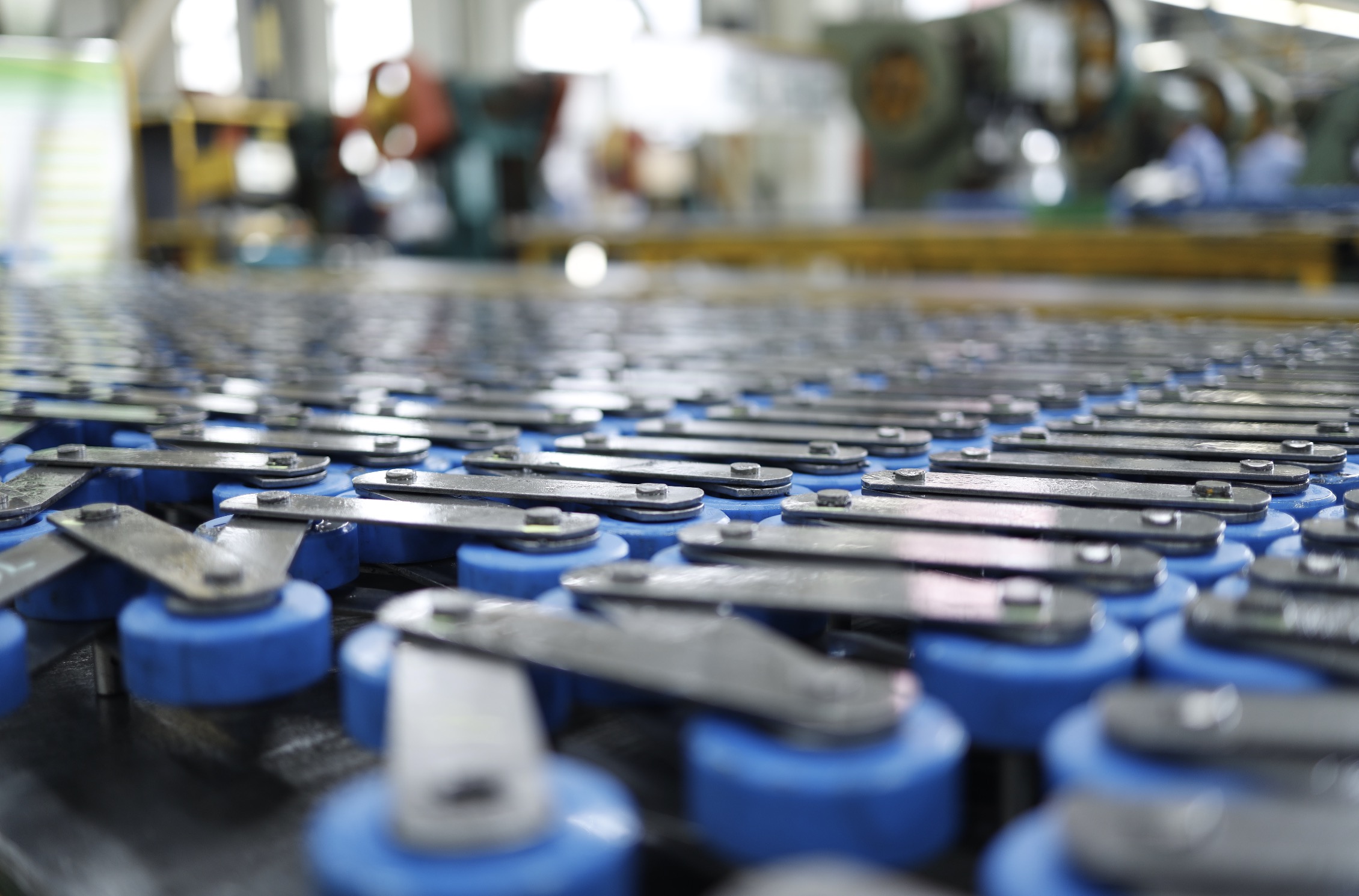When deciding whether a conveyor chain is right for your application, you need to understand how it works. Its installation includes the drive wheel, the slack strand, and one or more idler wheels that support the chain.
Idler wheels may be toothed or smooth and rest on rollers or plates. A drive wheel will push the load forward, while a slack strand will move the material backward.
Conveyor chains are operated by an ON/OFF button that rotates the motor. The motor determines the direction of movement of the load. The gears are networked together and move in the same direction as the motor.
The load is moved along the drive train until it reaches the last gear, which is the last gear. Some chain conveyors are unidirectional, but there are also bidirectional models available.
If you want to know how a conveyor chain works, continue reading this article.
What Is A Conveyor Chain?
A conveyor chain is a type of chain which is used in the conveyor system. It moves materials from one place to another by means of rollers and plates connected by chains. The pitch of a conveyor chain varies depending on the product being transported.
Lighter chains use UHMW Polyethylene tracks for wear resistance and lower power requirements, while heavier chains use special hardened alloy steel tracks with a higher load-carrying capacity and long life.
A conveyor chain is often used to move materials in industrial settings, and it can be a very reliable, cost-effective solution for certain applications. The main advantages of this type of chain are its low maintenance, high tensile strength, and ease of assembly. Many different applications require different kinds of conveyor chains, so it is important to find the one that best suits your needs.
The pitch of a conveyor chain is a measurement of how fast a sprocket rotates. The smaller the pitch, the faster the chain can rotate, but the larger the articulating angle, the higher the rotational speed.
The smaller the pitch, the more chain links are engaged during motion. A lower articulating angle, in contrast, produces less vibration and a smoother motion. There are several international standards for conveyor chains, but the British Standard is the most common.
How many types of conveyor chains are there?
There are several types of conveyor chains, each designed for specific functions and applications.
Roller Conveyor Chains
These chains consist of a series of rollers that reduce friction and enable smooth movement of materials. They are used in heavy-duty applications like automotive assembly lines, where they transport car parts and assemblies efficiently.
Attachment Conveyor Chains
These chains have attachments or extended pins that allow for additional components to be mounted on the chain. They are often used in material handling and packaging industries, where products need to be carried, lifted, or indexed.
Plastic Conveyor Chains
Made from durable plastic materials, these chains are lightweight and corrosion-resistant. They are commonly used in food processing, beverage, and pharmaceutical industries due to their hygienic properties and ease of cleaning.
Steel Conveyor Chains
Known for their strength and durability, steel conveyor chains (especially stainless steel conveyor chains) are used in heavy-duty applications like mining, construction, and bulk material handling. This heavy-duty conveyor chain can withstand harsh environments and heavy loads.
Slat Conveyor Chains
These chains consist of slats connected to the chain, forming a continuous surface for carrying products. They are used in manufacturing and assembly lines for transporting large or heavy items.
Top Chain
Top chains are designed with a flat top surface to transport products smoothly and securely. They are used in bottling and packaging industries where stable movement of products is essential.
Double Pitch Conveyor Chains
These chains have a longer pitch than standard roller chains, making them lighter and more economical for longer distances. They are used in applications like agricultural machinery and conveyors in distribution centers.
Leaf Conveyor Chains
Made of stacked plates, these chains provide high tensile strength and are used in lifting and hoisting applications, such as forklifts and cranes.
How Does a Conveyor Chain Work?
A conveyor chain is made up of a series of journal bearings that link together. The bearings contain a brush and pin, which helps the chain roller to move. The forces generated by the journal bearings must not be excessive since this can cause the belt to break. Additionally, the chain must be free of a torsion component. This can lead to transversal oscillations or speeds that are not optimum.
The main purpose of a conveyor system is feeding and conveying. The former involves moving materials from pickup points to drop points. The latter, on the other hand, involves delivering the product continuously or in batches.
The working mechanism of a conveyor chain includes the pulley system, which is an external component. The belt moves on the frame and needs to be supported to move smoothly. The pulley system has two rotors on each unit, while more complex systems have more.
The chain is supported by a drive wheel that rotates in a circular motion. The drive wheel exerts a force on the chain. The force is applied by friction and the load itself. A set of idler wheels supports the chain, which may be smooth or toothed, and rests on plates or rollers. The slack strand supports the chain.
The chains are bearings that are connected together by constraining link plates. It contains a brush and pin on which the chain roller revolves. When the power is on, the motor will rotate, and the chain will move. As the chain moves, it will move the material on the top as well. This is how a conveyor chain works to move material from one place to another.
Components of a Conveyor Chain System
Chain Links
The primary components that form the chain, provide the necessary length and flexibility. Each link is made up of two inner plates and two outer plates, connected by pins.
Rollers
Positioned between the inner plates, rollers reduce friction as the chain moves along the conveyor track. They enable smooth operation and minimize wear on the chain and track.
Pins
These cylindrical elements connect the chain links and allow them to pivot. They provide the necessary flexibility for the chain to bend and move along the conveyor system.
Bushings
Bushings act as bearings between the pins and rollers, reducing friction and wear. They are essential for the smooth and efficient operation of the conveyor chain.
Sprockets
Toothed wheels that engage with the chain, driving it forward or pulling it along. The size and number of teeth on the sprockets determine the speed and torque of the conveyor system.
Attachments
Additional components mounted on the chain links, such as extended pins or brackets. Attachments allow for the customization of the conveyor system to carry specific items or perform specific tasks.
FAQ
What is the difference between conveyor chain and roller chain?
Conveyor chains are designed for transporting materials and often have specialized attachments or slats. Roller chains, a type of conveyor chain, feature rollers to reduce friction and are used in both power transmission and material handling applications.
How to measure conveyor chain?
To measure a conveyor chain, measure the pitch (distance between pin centers), roller diameter, and inner width between link plates. These dimensions ensure proper compatibility with sprockets and system components, ensuring efficient operation.
How do you adjust and check a conveyor chain?
To adjust a conveyor chain, ensure proper tension by tightening or loosening it using the adjustment screws or tensioning device. Regularly check for wear, elongation, and alignment, ensuring the chain runs smoothly and efficiently without excessive slack or tightness.



